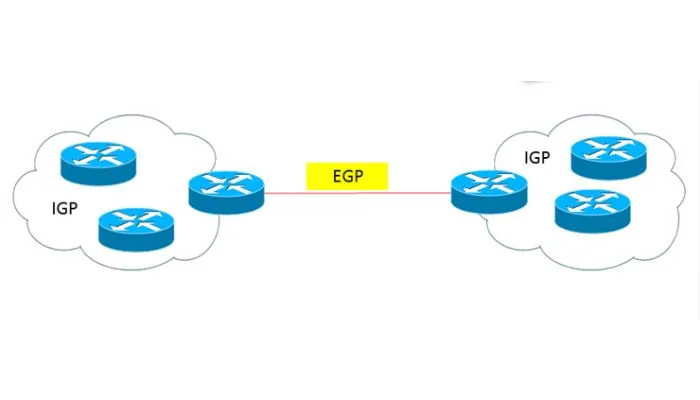The EGP (Exterior Gateway Protocol) is a crucial component in the world of computer networking. It plays a pivotal role in the exchange of routing information between autonomous systems (AS) within the internet. In this article, we will dive deep into the EGP protocol, exploring its workings, use cases, as well as its advantages and disadvantages.
What is EGP Protocol?
EGP, short for Exterior Gateway Protocol, is one of the oldest routing protocols used on the internet. It is designed to facilitate the exchange of routing information between different ASs (Autonomous Systems). ASs are individual networks or organizations that have control over their routing decisions and operate independently.
EGP operates at the network layer of the TCP/IP protocol stack and uses the reliable transmission control protocol (TCP) for its communication. It enables routers within different ASs to exchange network reachability information, allowing them to make informed routing decisions.

How Does EGP Work?
EGP follows a simple and straightforward working mechanism. When a Router within an AS wants to communicate with a router in another AS, it establishes a TCP connection. Once the connection is established, the two routers exchange routing information using EGP messages.
The EGP messages contain information about the available network prefixes and metrics, allowing routers to determine the best path for forwarding the data packets. The routers within an AS use their internal routing algorithms to select the appropriate next-hop router based on the received EGP information.
Here’s how the process works:
- EGP Messages: Routers within autonomous systems exchange EGP messages to share information about the routes they can reach. These messages contain vital details about the network, such as the IP prefixes they can reach and the preferred paths to reach those destinations.
- Neighbor Relationships: Routers establish neighbor relationships with routers in neighboring autonomous systems. These relationships enable them to exchange EGP messages and update their routing tables based on the information received.
- Routing Decision: When a router in one autonomous system receives EGP messages from a neighbor router in another AS, it processes this information and updates its routing table accordingly. The router determines the best paths for data packets to reach destinations in the remote autonomous system.
- Forwarding Data: Once the router has updated its routing table, it can effectively forward data packets to their intended destinations based on the most optimal routes. This ensures that data flows smoothly between autonomous systems.
It’s important to note that EGP operates on a larger scale than Interior Gateway Protocols (IGPs), which are used within individual autonomous systems to determine internal routing. EGP’s primary function is to enable routers in different autonomous systems to communicate and exchange data efficiently, contributing to the seamless functioning of the internet.
Use Cases of EGP
EGP has several use cases that make it an integral part of the Internet infrastructure:
- Interconnecting Autonomous Systems: EGP facilitates the exchange of routing information between different ASs, enabling seamless communication between networks operated by different organizations.
- Internet Service Providers: ISPs employ EGP to connect their networks with other networks, ensuring efficient routing and connectivity.
- Multi-homed Networks: Organizations with multiple connections to different ISPs use EGP to manage their routing and ensure redundancy in case of link failures.
EGP vs. IGP
It’s important to distinguish EGP from Interior Gateway Protocols (IGPs). While IGPs are used within an autonomous system to determine the best routes for data packets, EGP operates on a larger scale, helping routers in different ASs identify optimal paths to reach external networks.
| Aspect | EGP (Exterior Gateway Protocol) | IGP (Interior Gateway Protocol) |
|---|---|---|
| Scope | Interconnects autonomous systems (AS) | Operates within a single AS |
| Primary Use | Routing between different ASs | Routing within a single AS |
| Network Scale | Large-scale, global routing protocol | Smaller-scale, local routing protocol |
| Routing Information | Exchanges limited routing information | Shares comprehensive internal routing information |
| Route Decision Process | Focuses on identifying routes to external networks | Determines optimal routes within the AS |
| Routing Metrics | Typically based on administrative policies and preferences | Considers factors like hop count, bandwidth, and latency |
| Security Considerations | Vulnerable to security threats due to the exchange of routing information between ASs | Security concerns mainly revolve around preventing unauthorized access within the AS |
| Examples of Protocols | BGP (Border Gateway Protocol) is a common EGP | RIP (Routing Information Protocol) and OSPF (Open Shortest Path First) are common IGPs |
Advantages of EGP
EGP offers several advantages that contribute to its widespread usage:
- Simplicity: EGP is a simple protocol that is easy to implement and configure.
- Compatibility: EGP is compatible with various network architectures and can be used in different types of networks.
- Scalability: EGP can handle large routing tables, making it suitable for networks with a vast number of routes.
Disadvantages of EGP
Despite its advantages, EGP also comes with certain limitations:
- Limited Convergence Speed: EGP’s convergence speed is relatively slow compared to other routing protocols, which can impact network performance.
- Lack of Advanced Features: EGP lacks certain advanced features, such as load balancing and traffic engineering, which are available in newer routing protocols.
EGP protocol plays a crucial role in the exchange of routing information between autonomous systems on the internet. Its simplicity, compatibility, and scalability make it a preferred choice for interconnecting networks. However, its slower convergence speed and lack of advanced features are some of its limitations. Understanding the EGP protocol and its use cases is essential for network administrators and professionals working in the field of computer networking.
